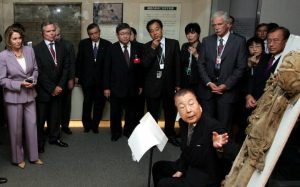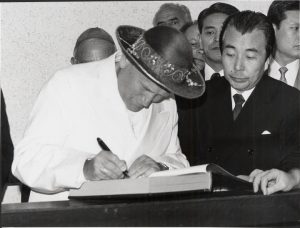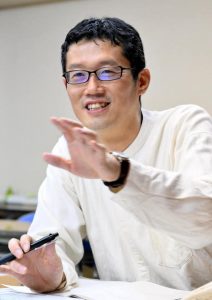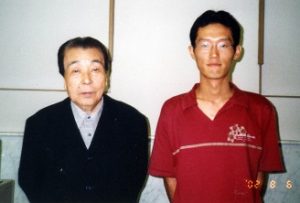My guidepost, Hiroshima pioneers: Seiichiro Takemine, 46, professor at Meisei University, speaks about Akihiro Takahashi, A-bomb survivor
Jul. 3, 2023
Fateful encounter turns into lifetime of communication
by Kyoko Niiyama, Staff Writer
For his research, Seiichiro Takemine often visits the Marshall Islands, located in the central Pacific Ocean, the site of 67 nuclear tests conducted by the United States. Around 25 years ago, Mr. Takemine began interviewing local residents who were suffering from effects caused by the nuclear testing. His personal philosophy is to cherish each of his encounters. He was taught to do so by Akihiro Takahashi, an A-bomb survivor and former director of the Hiroshima Peace Memorial Museum, located in the city’s Naka Ward, who died in 2011 at the age of 80.
Mr. Takemine began communicating with Mr. Takahashi about 20 years ago. The impetus behind their relationship was a project that entailed written communication between A-bomb survivors and young people that the Japan Confederation of A- and H-Bomb Sufferers Organizations (Nihon Hidankyo; headquartered in Tokyo) put together through its organizational newsletter. In his messages to young people, Mr. Takahashi addressed such issues as poverty and the suppression of human rights around the world, as well as global warming, while also asserting that the dropping of the atomic bombs was an act of terrorism by the United States. He included his hope that young people would “look at the world with eyes wide open,” with Hiroshima as the starting point. “Those words reverberated through my heart and soul just as I was starting my research on the Marshall Islands as a graduate student,” Mr. Takemine said.
On August 6, at that time 20 years ago, Mr. Takemine visited Hiroshima and met with Mr. Takahashi. After speaking with him in person, Mr. Takemine realized that Mr. Takahashi was someone with a broad perspective who spoke about Hiroshima as a global issue. Thereafter, each time he visited Hiroshima, Mr. Takemine would take the opportunity to meet with Mr. Takahashi. At the same time, as he developed a friendship with Mr. Takahashi’s wife, Fumie, 86, Mr. Takemine came to learn more about the terrifying half of Mr. Takahashi’s life.
Mr. Takahashi experienced the atomic bombing when he was 14 years old on the school grounds of Hiroshima Municipal Junior High School (present-day Motomachi High School), about 1.4 kilometers from the hypocenter. He suffered severe burns over his entire body and hovered between life and death. He ultimately survived, but his fingers and elbow on the right side of his body remained fixed in a bent position. He experienced discrimination in employment. Even after he managed to get a job at Hiroshima City Hall, he continued to struggle due to prejudice from those around him and his own health concerns. Hoping to share his suffering with people in similar circumstances, he paid a visit to Kiyoshi Kikkawa, who was known as “Atomic Bomb Victim No. 1” at the time and led an early A-bomb survivor’s organization. It was then that Mr. Takahashi joined the A-bomb survivor’s movement and the campaign against atomic and hydrogen bombs.
Soon, however, Mr. Takahashi grew frustrated with the movement, which was defined by political tactics and the maintaining of appearances, ultimately distancing himself from them. Story has it that his tendency to adhere to his own beliefs led to clashes with other members. Aiming at creating a peace movement that he could carry out on his own, he began to focus on passing on his experience in the atomic bombing to the next generations. With cooperation from Goro Shikoku, a painter and former colleague of his at city hall, he wrote about his A-bombing experience in a picture book titled Hiroshima no Otosan (in English, ‘Father of Hiroshima’) and, in that way, continued to share his experiences through writing, which he considered a strength of his.
While serving as director of the Peace Memorial Museum, he guided Pope John Paul II and other dignitaries around the museum, conveying the inhumanity of nuclear weapons to the world as a “living witness.” In 1980 when an A-bomb exhibit was held in Washington, D.C., he met with Paul Tibbets, captain of the Enola Gay, the bomber that dropped the bomb on Hiroshima. Mr. Tibbets said at that time that he would drop the bomb again were orders given to do so. Nevertheless, Mr. Takahashi continued to correspond with Mr. Tibbets.
“Mr. Takahashi probably believed that, no matter who it is, there can be common points of understanding,” said Mr. Takemine. Mr. Takahashi frequently communicated in particular with younger generations of the same ages as his children and grandchildren. Mr. Takemine frequently received letters from Mr. Takahashi that included reports on his testimonial activities and his thoughts and feelings about the world situation and other issues. Whenever Mr. Takemine wrote back to report on the progress of his research into nuclear damage on the Marshall Islands, Mr. Takahashi always provided him with words of encouragement. Mr. Takemine said, “I think that, through our repeated communication, he tried to convey the hopes of the citizens of Hiroshima to us of the younger generations.”
Mr. Takemine watched over Mr. Takahashi, who continued to talk about his A-bombing experiences from a wheelchair and was repeatedly in and out of the hospital, in his later years. Mr. Takahashi said, “The reason I continue to share my account despite my advanced age and ailments is to make people aware that Hiroshima and Nagasaki are not merely occurrences of the past but an issue of the here and now and have them turn their attention to the world.” Mr. Takemine now realizes the significance of the words left by Mr. Takahashi as he continues his research on “global hibakusha,” people who have been exposed to nuclear weapons around the world.
One phrase that Mr. Takahashi treasured so much that he wrote it on his business card was “Ichie Issho,” with the meaning that chance encounters can last a lifetime. Mr. Takemine believes the “Father of Hiroshima” was the embodiment of that idea.
Seiichiro Takemine
Born in Itami City, Hyogo Prefecture, Mr. Takemine received a doctorate degree from Waseda University Graduate School of Asia-Pacific Studies. His specialties are international sociology, peace studies, and regional studies of the Pacific islands. He is the author of Marshall Shoto: Owarinaki Kakuhigai wo Ikiru (‘Marshall Islands: Living through endless nuclear damage’; published by Shinsensha), and others. Mr. Takemine has visited the Marshall Islands 17 times since 1998 and stays there several weeks at a time to continue his work of conducting interviews with local inhabitants. He currently is a resident of Hiroshima’s Minami Ward.
Keywords
Succession of directors at Peace Memorial Museum
The museum director is a “guide to the A-bombed city” as the leader of the facility responsible for conveying the tragedy of the atomic bombing. The first director was Shogo Nagaoka, who devoted himself to the collection of items exposed to the atomic bombing from amid the ruins of the city. Mr. Nagaoka was appointed director of the museum in 1955, when it first opened, and served until 1962. Akihiro Takahashi (who served in the position 1979–1983) was the seventh director. The next directors were Yoshitaka Kawamoto (1983–1993) and Hiroshi Harada (1993–1997), both of whom were A-bomb survivors, with the tenth director being Minoru Hataguchi (1997–2006), who was an in-utero A-bomb survivor. The 11th director was Koichiro Maeda (2006–2013), who was born after the end of the war. The current director is Takuo Takigawa, the 13th person in the succession of museum directors.
(Originally published on July 3, 2023)











